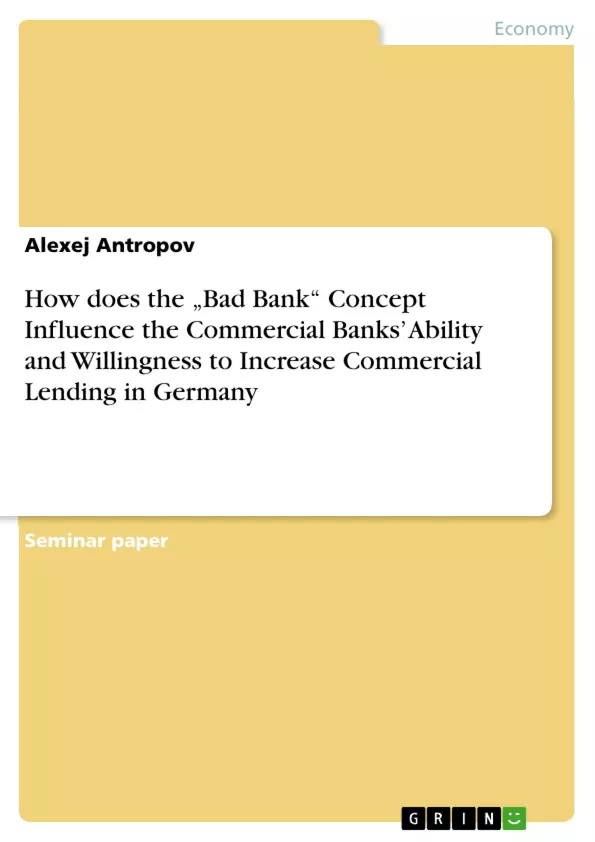During the Financial Crisis 2007-2010, which was the result of housing bubble in the
United States in 2006, commercial banks rapidly decreased the amount of commercial
lending worldwide. So called subprime credits made the assets of commercial banks
less worth during a short period. It was the cause for the credit crunch in many
economies. Because many enterprises have to rely on debt capital, which they lend from
commercial banks to finance their investments, the credit crunch hit such enterprises
very hard. The outcome is that the whole economy suffers. Many governments
elaborated the bad bank concept to solve the problem of decreased commercial lending,
also Germany. It means, that banks will be allowed to start special purpose vehicles
(SPV) for holding the subprime credits and to bring such subprime credits out of the
balance sheet of the bank. In Anglo-Saxon countries there are two other terms in use for
SPV: (loan) recovery agency and asset management company. According to Homoelle,
Ruff and Tuerr1 in theory and praxis there are many variants of bad bank models
existing. Until now the question which model is most successful, became insufficient
exploration.
German government adopted two different models of bad banks and proposed the
Financial Market Stabilisation Act (FMStFG), which became effective on July 22th
2009.2 After that some banks used this opportunity and transferred their subprime assets
to such SPV.
The scope of the work is first to evaluate why exactly commercial banks decreased the
commercial lending, second to analyse German bad bank concept and then to work out
the incentives of this concept for more commercial lending by commercial banks and to
show some examples of implementation of bad bank concept by German banks. At the end the answer on the question, whether the bad bank concept increases the ability and
willingness of German commercial banks to make more commercial credits available or
not, will be given in this term paper.
Table of Contents
- 1. Introduction
- 2. Why Commercial Banks Decreased the Commercial Lending?
- 2.1. Financial Crisis 2007-2010
- 2.2. Decrease in Commercial Lending
- 3. German Bad Bank Concept
- 3.1. How Does the Bad Bank Model Work?
- 3.1.1. Special Purpose Vehicle Model
- 3.1.2. Consolidation Model
- 3.2. Purposes
- 3.1. How Does the Bad Bank Model Work?
- 4. First Experiences with Bad Banks
- 4.1. WestLB AG
- 4.2. Hypo Real Estate Holding AG
- 5. Conclusions
Objectives and Key Themes
This term paper aims to analyze the influence of the "Bad Bank" concept on the ability and willingness of commercial banks to increase commercial lending in Germany. It focuses on the context of the 2007-2010 financial crisis and the subsequent measures taken by the German government to stabilize the financial market.
- The impact of the 2007-2010 financial crisis on commercial lending in Germany.
- The concept of "Bad Banks" and their role in addressing the financial crisis.
- The specific models used for establishing Bad Banks in Germany.
- The effectiveness of Bad Banks in promoting commercial lending.
- Case studies of WestLB AG and Hypo Real Estate Holding AG.
Chapter Summaries
- Chapter 1: Introduction introduces the topic of the term paper, outlining the research question and the significance of the topic in the context of the financial crisis.
- Chapter 2: Why Commercial Banks Decreased the Commercial Lending? analyzes the impact of the 2007-2010 financial crisis on commercial lending in Germany. This chapter explores the causes of the decline in lending activity, discussing the role of market uncertainty and risk aversion.
- Chapter 3: German Bad Bank Concept provides a comprehensive overview of the German "Bad Bank" concept. It examines the different models used for establishing these institutions, including the Special Purpose Vehicle model and the Consolidation model, and outlines the purposes for which they were established.
- Chapter 4: First Experiences with Bad Banks examines the experiences of WestLB AG and Hypo Real Estate Holding AG in dealing with Bad Banks. This chapter provides insights into the practical implementation of the Bad Bank concept and its impact on the specific institutions.
Keywords
The key terms and concepts explored in this term paper include: Bad Bank, commercial lending, financial crisis, financial market stabilization, Special Purpose Vehicle, Consolidation model, WestLB AG, Hypo Real Estate Holding AG, and Germany.
- Citar trabajo
- Alexej Antropov (Autor), 2010, How does the „Bad Bank“ Concept Influence the Commercial Banks’ Ability and Willingness to Increase Commercial Lending in Germany, Múnich, GRIN Verlag, https://www.grin.com/document/170907



